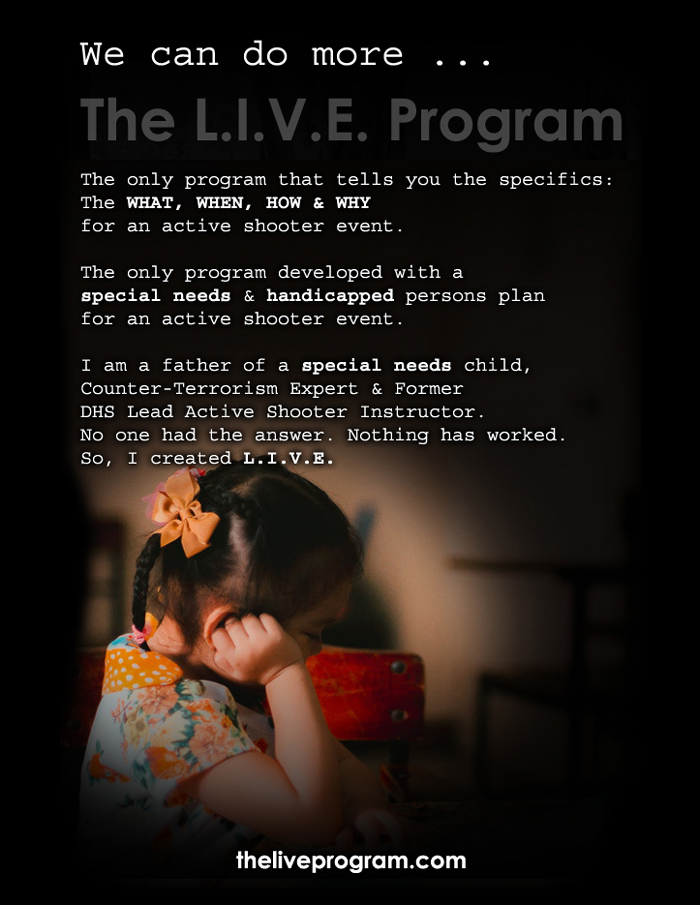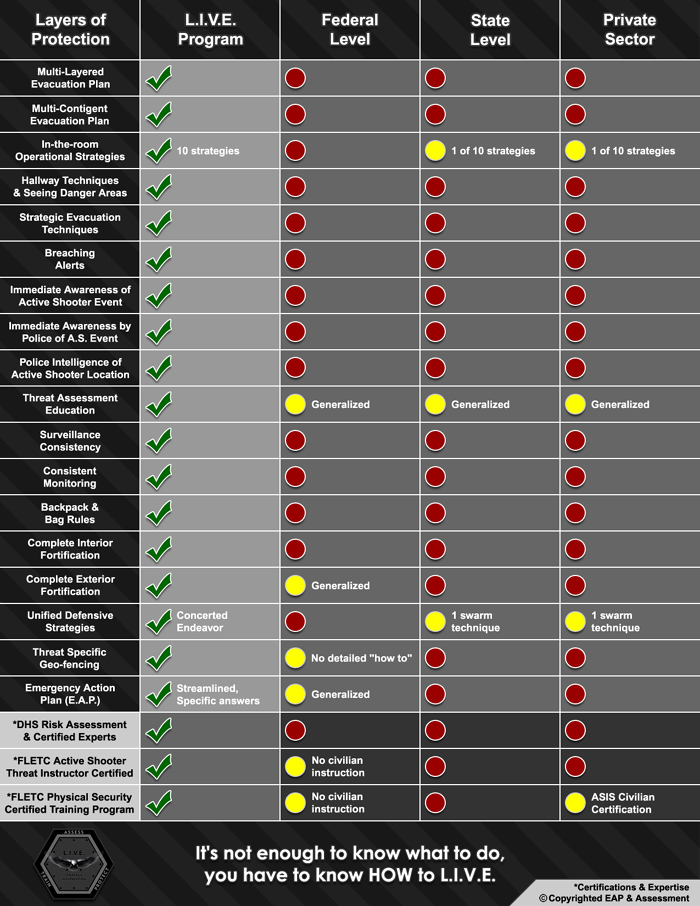The L.I.V.E. Program Active Shooter Training
It's not enough to know what to do, you have to know HOW to L.I.V.E.
It's not enough to know what to do, you have to know HOW to L.I.V.E.
It's not enough to know what to do, you have to know HOW to L.I.V.E.
The Proof is in the People
The L.I.V.E. Program Presentation
" Our program protects people in those first critical minutes giving law enforcement enough time to arrive. "
- Matt Estridge

Our Mission
The L.I.V.E. Program protects people in those first critical moments when there is no help. L.I.V.E. provides unprecedented and holistic emergency preparedness solutions, including but not limited to, prevention, deterrence and defense with step-by-step response solutions taking into consideration persons with disabilities and special needs. L.I.V.E. encompasses practical, intuitive and evidence-based life skills and addresses historical deficiencies via a holistic preparedness approach. The solutions within this approach were never before seen until the creation of L.I.V.E.The Numbers
There have been 250 active shooter incidents between 2000-2017. From 2000-2015, businesses comprised of half of all incidents with schools being number two with 44 incidents. In 2017, there were 23 active shooter incidents. So far in 2018, there have been 23 school shootings where someone was hurt or killed. This year is averaging more than 1 shooting a week. Three school shootings took place in May alone, with 10 people being killed at Santa Fe, Texas where two school resource officers were assigned and on site. Parkland and Santa Fe equaled 27 fatalities and 30 casualties.University of Tennessee
Perspective of a Tennessee Teacher


Highlighted References for the L.I.V.E. Program
- The Department of Homeland Security (DHS) Federal Law Enforcement Training Center (FLETC), with exception of DEA and FBI, is the premier academic and tactical authority for all federal law enforcement. The DHS FLETC Program Specialist for the Active Shooter Threat Instructor Training Program (ASTITP) (former U.S. Head for Customs and Border Protection SAM mission Department of State for Eastern Europe) believes so strongly in the L.I.V.E. Program and its unprecedented solutions, he requested and was given Director approval to be a reference.
- FBI Senior Special Agent of Maritime Operations specifically requested our Senior Instructor to assess the critical access points of the U.S. ports. The official letter can be provided upon request.
- The Tennessee Emergency Management Association (TEMA) President, University of Tennessee Emergency Management Director and 23yr Marine (Ret), Brian Gard, implemented The L.I.V.E. Program in a pilot at the University of Tennessee in July of 2019. The Director stated the L.I.V.E. Program has practical answers that are new to the body of work of active shooter. Gard goes on to say other programs have only addressed "what" to do; never the "how.".
(See Director Gard's video testimonial and all of our testimonials via The L.I.V.E. Program testimonials tab.) - Letter of recommendation provided by an FBI Agent touted the unprecedented solutions of this program (recommendation letter available)
Channel 10 News Interview in the wake of the Santa Fe Shooting
Channel 10 News Interview in the wake of the El Paso & Dayton Shootings


- Custom threat assessment by former federal law enforcement certified active shooter instructors, counterterrorism agents, and special operations personnel
- Recertification on an annual basis for new personnel, facility changes, and evolution of active shooter trends
- Coordinate a practical assessment involving local law enforcement and present detailed results of areas needing improvement

- Customized emergency action plan (EAP) which outlines the following: securing the facility, implementing lockdown procedures and countermeasures, and coordinating with local law enforcement
- Step-by-step guide to creating a standard operating procedure (SOP) to empower people and increase their ability to ensure safety
- Comprised of staff and partners who educate on trends, behavior indicators, medical considerations, and technological tools

- The L.I.V.E. Program utilizes ten (10) self-defense strategies to defend against an attacker when they enter the room you occupy and instructs in detail the WHY, WHEN, HOW and the WHAT to do during an active shooter incident.
- The L.I.V.E. Program shows individuals how to see danger areas ahead before entering hallways, stairs, elevators, and rooms in order to evade and evacuate a building to safety using evaison strategies, cover and concealment.
- The L.I.V.E. Program takes into account special needs and handicapped individuals by utilizing the unique knowledge and understanding of The L.I.V.E. Program founder, Matt Estridge.

The L.I.V.E. Program
Current national standards for active shooter response have been shown to be ineffective (i.e. DHS "Run, Hide, Fight" and like programs). Texas Attorney General Ken Paxton, Tactical Expert Mike Wood, Department of Justice Expert Jillian Peterson, the FBI and DHS, and many other agency heads concur that nothing has worked. People must be able to defend themselves because law enforcement cannot be everywhere nor do any more from a preemptive standpoint.To optimally protect those in our charge, significant improvements are needed. To prevent a massive loss of lives, a threat perspective preparedness plan that accounts for the first critical seconds and minutes of an active shooter event is needed. Seconds save lives. Advancing detection and deterrence, as well as providing life-saving guidance to our schools, places of business, hospitals and worship centers. Our goal is to reset the national standard in protective care in the crucial moments when help is unavailable.
The following eight (8) components provide an effective active shooter preparedness plan that considers the first critical seconds that save lives before law enforcement arrive:
- Unarmed life-saving assailant room entry countermeasures
- Ten self-defense strategies that compliment and work in concert to defend against an attacker when they enter a room (24/7 online supplemental resources)
- Strategies provided via detailed step-by-step instruction tailored to that facility and personnel for the best possible outcome
- Unarmed life-saving assailant room entry countermeasures and threat assessment education are life skills that transfer into any environment (i.e. parking garages, malls, theaters, sporting events, restaurants, even at home, etc)
- Preemptive danger-identifying strategies, with accompanying methods of evacuation
- Strategies for protective and surreptitious evasion and evacuation
- Multi-contingent and multi-layered evacuation protocols with protective measures
- Multi-layered intelligence gathering/reporting
- Detailed evacuation countermeasures if confronted by an active shooter
- Threat assessment education/life skills
- Team building and rapport building for teachers, staff, and students
- Behavioral education and conflict training for active shooter detection and deterrence
- Emergency Action Plan (EAP) creation, provision, and instruction ©
- Totality of threats perspective (i.e. assault on a facility and its occupants)
- Articulated responsibilities directive encompassing all solutions for training, coordination, and implementation of each facility's individualized plan
- Expertly individualized high-value target security assessments ©
- Point of view of an assault on a facility and occupants to detect and deter active shooters
- Systematic notifications, consistent monitoring, intrusion notifications, access fail safes, common area protections, etc
- Specific and detailed guidance for Individualized Education Plans (IEP) and businesses for evading, evacuating, and protecting special needs individuals
- Security trained in Tier 1 Special Ops tactics (i.e. Delta Force)
- Single person to multi-team tactical active shooter response
- Tactical advantage and faster response time
- Qualifications and certifications
- Certified by Department of Homeland Security (DHS) Federal Law Enforcement Training Center (FLETC) Active Shooter Threat Instructor Training Program (ASTITP)
- Senior Assessor requested by the FBI to revamp assessment protocols for U.S. ports of entry (request letter available)
- Senior Assessor served as an instructor on behalf of the United States to our international allies
- Senior Assessor is a leading risk/vulnerability expert for the Director of National Intelligence
- Instructors have been full-time federal law enforcement instructors, teaching active shooter training and developing curriculum
- Instructors are certified by DHS FLETC in risk and vulnerability assessments.
- Senior Instructor is a former Green Beret, Delta Force Operator (CAG/The Unit), and recruited to lead a federal law enforcement specialized unit, and an expert in active shooter countermeasures
- Instructor cadre make-up is veteran special operations personnel, counter-terrorism agents, and subject matter experts.

The Case
A judge in a Hennepin County, Minneapolis courtroom found and upheld a ruling that a civil lawsuit for the families of the victims in a workplace violence related active shooter incident can proceed in a narrow yet newly expanded format. The lawsuit was filed and brought by the family members and surviving employees of the active shooter incident that occurred at the Accent Signage Systems.On Tuesday, July 2, 2013 the District Court Judge, the Honorable Denise Reilly stated that the family of Jacob Beneke can proceed with two negligence counts against Accent Signage Systems. The scope of the ruling states that the suit can proceed for failing to include language in their polices along with training for their employees that mitigates workplace violence situations and trains employees how to survive a critical incident.
The charges basically follow the OSHA guidelines set forth under the "General Duty Clause" that the employer needed to make training available and reasonable safeguards to be put in place. One of the victims, Beneke's family sued the Accent Signage and Engeldinger's estate in February. Releasing the shooters estate from liability and holding the company responsible is a new shift in thoughts regarding pre-planning and prevention. Engeldinger shot and killed Beneke, and four other employees and co-workers along with a UPS deliveryman before committing suicide on September 27, 2012.
Common Misconceptions and Weaknesses
- "It will never happen to me" - until it does. Accent Signage Systems, Youtube Headquarters, Parkland, Newtown and Santa Fe schools and others probably said the same
- The majority of active shooter events are over before law enforcement ever arrives.
- Law enforcement needs time.
- The L.I.V.E. Program enpowers businesses and academic institutions to give law enforcement that time.
We do this by: - Teaching the safest manner of movement
- Teaching the safest manner to evacuate
- Teaching the safest manner to protect against an active shooter who enters the room they occupy
- Law enforcement is only able to give general instructions when it comes to protecting and defending oneself and others during an active shooter event due to liability and/or policy.
- Our program picks up where law enforcement cannot.
We do this by: - Teaching civilians, who are not armed, life saving countermeasures during critical incidents.
- Conducting security assessments and developing emergency response plans.
- Implementing the L.I.V.E. (Lock, Instruct, Vantage point, Engage) principle.
- Locking the door and hiding is a defective answer to defend against the active shooters who have shot through glass or doors to enter. A multilayered security approach conducted by trained individuals is imperative. Training includes identifying facility weaknesses, choke points, methods to harden entries and rooms, and physical techniques to evade, escape, and defend if necessary.

Why you need this training
Reduce business liability by creating Standard Operating Procedure (SOP), coordinate SOP with first responders, and conduct active shooter response countermeasures training for your business and employees to mitigate loss of life and deter active shooter events.You are responsible for who you employ, their safety and well-being. As of Tuesday, July 2, 2013 a court has spoken and found you are responsible as well. A judge found an employer is responsible for their employee's during a critical incident. The scope of the ruling states that the suit can proceed for failing to include language in their polices along with training for their employees that mitigates workplace violence situations and trains employees how to survive a critical incident.
"The challenge for law enforcement agencies and officers, then, is to overcome not only the attacks taking place in schools, but to first overcome the denial in the minds of mayors, city councils, school administrators, and parents. Grossman said that agencies and officers, although facing an uphill slog against the denial of the general public, must diligently work toward increasing understanding among the sheep that the wolves are coming for their children. Police officers must train and drill with teachers, not only so responding officers are intimately familiar with the facilities, but so that teachers know what they can do in the event of an attack."
- Army Psychologist, Lt. Colonel Grossman
"Arming people with knowledge is the answer to mitigating casualties."
- Matt Estridge
Additional Program Services
- We help you partner with your local law-enforcement to conduct drills throughout the year.
- We offer additional trainings for medical preparedness in a critical incident.
- We conduct scenario based training to test, evaluate and access your preparedness.
- We offer recertification each year as trends evolve and personnel changes occur.
- We have the option for active shooter countermeasures training online to maintain your proficiency.


